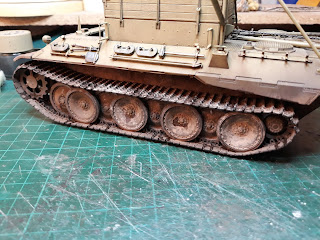The kit is progressing quite nicely as the fuselage is glued together, the lower wing and tail plane are on and I glued the cowling together as a sub assembly rather than separately which will make painting easier later
As the aircraft I want to do has the anti-spin strakes fitted to the rear fuselage, Airfix supply an alternative tail with them moulded on however some surgery is required to the fuselage. Airfix supply a jig that fits over the rear fuselage with the idea that you sand down the area however I found it easier to score it with a modelling knife and remove the section of fuselage that way.
A word of caution here as you need to tape the jig (DO NOT GLUE IT) to the fuselage otherwise you may end up with an uneven cut that will lead to a lop-sided tail-plane.
Before fitting the tail I lightly scored the elevators and cut the top rudder hinge line so that I could offset them.
Before the lower wing was glued into position I removed the moulded detail ready for the etch replacements then the wing was glued into place with some filler being needed after it had set. The struts were glued to the top wing and left to set and before the two venturi's were glued to the fuselage, holes were drilled either end of them to improve the look.
After looking ahead at the rigging instructions it wasn't clear what the rudder cables attached to on the fuselage sides as Airfix moulded a weird 'L' shaped section so after studying photos of a real Tiger Moth these 'L' sections should actually be a rectangular plate with a slot where the rudder mechanism sticks out.
With that I scraped off the moulded detail and made new plates from thin styrene sheet with a slot engraved using a pin and a straight edge, triangular pieces were cut from the same size styrene sheet for the rudder cable mountings. Remembering that I off-set the rudder, the cable mounts were off-set too then these assemblies were glued to the fuselage sides.
The holes were drilled out for the rigging and although the rigging instructions are pretty good Airfix missed where the elevator cables go through the fuselage. After figuring out as-near-as-dammit where they are I drilled holes into the fuselage through to the other side then added reinforcement patches from 1.5mm thin styrene discs punched out using my RP Toolz punch and die set (a very useful piece of kit) with holes drilled into the centres. These were then glued into place. Hopefully they won't stand out so much after a layer of paint;
At the risk of over thinking this model (like I usually do) I have to say I have really enjoyed it so far as it is has been a really pleasing kit to work on and not become a chore like other recent builds, however this may change when the time comes to fix the top wing in place.

















